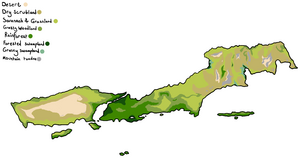Okrit
Okrit comprises a small archipelago west of the greater Attu archipelago. Formerly, Okrit remained completely isolated from the rest of the world for many years due to atmospheric phenomena causing thick fog and storms. By 9 PC, these storms had cleared to the point where ships from the east finally made contact with the archipelago.
- Established: 9-11PC
- Capital: Nkrama
- Current leader: Aakar Orit
History
Prior to national union, political power was split between multiple states based mostly on ethnic boundaries. Directly prior to 9PC, the most powerful of these states were the predominantly Efiyye kingdom of Masrit, the Taaqbal federation and the various City States along the Omolai.
Civilization on Okrit dates back many centuries, however the most prominent and influential of Okrit's ancient peoples were the Ukubians, whom ruled of a great empire that spanned most of the islands. Many remnants of the Ukubians can still be seen today through their architecture and craftsmanship. The ethnically Ofot kingdom of Okso claimed direct heritage from the Ukubians - and it is from this tradition the term 'Okrit' originates, meaning 'land of the ancients'
The kingdom of Okso was founded near the foothills of the highlands around 1200TT and was a rather powerful and influential kingdom at it's peak, thriving off of great military and economic strength. The collapse of Okso came about in the late 500-400sTT, after heavy raiding from the highlands, followed by a failed invasion and subsequent civil war.
The kingdom of Masrit was founded in 564TT by it's first Udumap, Aazab Matras, who led a coalition of Efiyye city states against neighbouring tribes who frequently raided the the lands. After this successful conquest, the coalition formally united through an electoral monarchical system under the council of dukus, who elected Aazab Matras as their Udumap, with the capital, and later namesake of the nation, being the minor mining city of Masrit.
The United Okrit Government was established in 9PC by Nkrama political official Aakar Orit after the outbreak of the eastern-borne Purple Fever.
Geography
The archipelago of Okrit consists of two main islands separated on an East-West axis by a shallow straight. The eastern island of Onomat is the largest island within the archipelago and is home to the majority of the population. The western island of Waaq, whilst less densely inhabited, still maintains substantial influence throughout all the islands. The straight that separates the two islands is known throughout the archipelago as the Omolai.

Onomat is geographically split into the lowlands and highlands in the west and east respectively. The lowlands cover a mostly flat plain that is at its flattest at the westernmost point, become gradually more coarse and hilly heading eastwards. The western lowlands are majority forested, giving way to grasslands and coastal marshes in the rockier eastern terrain. Eventually the hillsides give way to the mountains of the highlands, which while comparatively drier, still hold a large diversity of resources and ecosystems.
The eastern and coastal regions of Waaq are similarly forested and share a large range of flora and fauna. Heading inland the terrain gives way to a mountain range cradling a dry plateau in the centre of the island.
Culture
The various people groups of Okrit maintain a vast array of distinct cultural identities that have been solidified over the course of history on the archipelago. While this does indeed make for a great multitude of differences and subsequent conflicts between the groups, years of mutual influence and shared heritage still shine through.
The largest cultural divides mostly lie along equally drastic geographical divides, the most prominent of which being the separation of the highlanders from the lowlanders. The lowlander denominations make up the majority of the population of Okrit, and subsequently have the most cultural and political influence in the nation. Traditionally, the lowlanders are split into 5 cultural groups excluding the Peye of the southern islands, those being the Amata, Efiyye, Oye, Ofot & Taaqbal, however regional variation and influences is prevalent throughout all of them.
Economy
Historically Okrit had an economy focused on the trade of minerals from Waaq to the Onomat lowlands in exchange for food. The highlands bare a large variety of resources mineral, dietary and luxury, making it of very high value. The Onomati lowlanders have historically attempted to conquer the highlands countless times, however this has been hindered by the rough terrain and hostility of the highlanders alongside political plays of the Waaqi who rely primarily on Onomati for food supply.